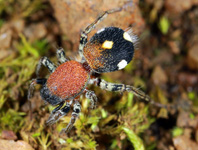Abstract
Moulds (2012) established the genus Mugadina for two small cicadas, M. marshalli (Distant) and M. emma (Goding and Froggatt), both grass inhabiting species known from Queensland and New South Wales. Both species are notable for their relatively simple 'ticking' songs. Moulds further noted that there were at least two superficially similar genera of cicadas, but each with different genitalia. This paper describes two new genera of small (9–15 mm body lengths) and distinctive grass cicadas with genitalia that are very similar to those of Mugadina, but possess clear morphological, colour and calling song differences. The new genera are: Heremusina n. gen. with two known species namely H. udeoecetes n. sp. and H. pipatio n. sp.; the second new genus is Xeropsalta n. gen., containing four known species, X. thomsoni n. sp., X. aridula n. sp., X. rattrayi n. sp., and X. festiva n. comb. Heremusina n. gen. species are described from the Alice Springs area of Northern Territory and the Cloncurry area of northwest Queensland, from arid to semi arid habitats. The Xeropsalta n. gen. species are described from western, southwest and central Queensland, and from the Simpson and Strzelecki Deserts in northeastern South Australia and northwestern New South Wales, respectively, all locations in very arid to arid habitats, but close to seasonal (often irregular) rivers and lakes. X. festiva n. comb. occurs in semi arid habitats in southern and southeastern Australia.
Detailed taxonomic descriptions are provided of the new species, together with distributions, habitats, and the calling songs. The Heremusina species emit songs with short repetitive buzzing echemes, the echeme durations differing between each species. The Xeropsalta songs are notable for their complexity, containing multiple elements with rapid changes of amplitudes and temporal structures, rather atypical of the songs of most small grass dwelling cicadas. Detailed song structures distinguishing each of the species are illustrated and interpreted in each case in light of their respective taxonomic status.
References
Bennet-Clark, H.C. (1997) Timbal mechanics and the control of song frequency in the cicada Cyclochila australasiae. The Journal of Experimental Biology, 200, 1681–1694.
de Boer, A.J. (1999) Taxonomy and biogeography of the New Guinean Cicadettini (Hemiptera, Tibicinidae). Mitteilungen Museum Naturkunde Berlin: Deutsche entomologische Zeitschrift, 46, 115–147.
https://.doi.org/10.1002/mmnd.19990460202.Dugdale, J.S. (1972) Genera of New Zealand Cicadidae (Homoptera). New Zealand Journal of Science, 14, 856–882.
Emery, N.J., Emery, D.L. & Popple, L.W. (2015) A redescription of Yoyetta landsboroughi (Distant) and Y. tristrigata (Goding and Froggatt) (Hemiptera: Cicadidae) and description of four new related species. Zootaxa, 3948 (3), 301–341.
http://dx.doi.org/10.11646/zootaxa.3948.3.1Ewart, A. (2009) Cicadas of the eastern segment of the Cravens Peak Reserve, northeastern Simpson Desert, S.W. Queensland: January/February 2007. In: Hayley Freemantle (Ed.), Cravens Peak Scientific Study Report. The Royal Geographical Society of Queensland Inc., Brisbane; Geography Monograph Series, 13, 117–150. [ISBN 978-0-949286-16-8]
Ewart, A. & Popple, L.W. (2013) New species of Drymopsalta heath cicadas (Cicadidae: Ciacdettinae: Cicadettini) from Queensland and Northern Territory, Australia, with overview of genus. Zootaxa, 3620 (1), 1–42.
https://doi.org/10.11646/zootaxa.3620.1.1Ewart, A., Popple, L.W. & Marshall, D.C. (2015a) New species of Simona Moulds, 2012 and Chelapsalta Moulds, 2012 cicadas (Cicadidae: Cicadettinae: Cicadettini) from Australia: comparative morphology, songs, behaviour and distributions. Zootaxa, 4001 (1), 1–65.
https://doi.org/10.11646/zootaxa.4001.1.1Ewart, A., Moulds, M.S. & Marshall, D.C. (2015b) Arenopsaltria nubivena (Cicadidae: Cicadinae: Cryptotympanini) from the Arid Regions of Central Australia and Southwest Western Australia. Records of the Australian Museum, 67, 163–183.
https://doi.org/10.3853/j.2201-4349.67.2015.1643
Gogala, M. (2013) On the trail of the mountain cicadas; [translation Petra Pavlovčič]. Slovenska akademija znanosti in umetnosti, Ljubljana, 173 pp. [ISBN 978-961-268-024-4]
Haywood, B.T. (2006) A study of the cicadas (Hemiptera: Homoptera) in the south east of South Australia. Part I. South Australian Naturalist, 80, 12–23.
Marshall, D.C., Hill, K.B.R., Cooley, J.R. & Simon, C. (2011) Hybridization, mitochondrial DNA taxonomy, and prediction of the early stages of reproductive isolation: Lessons from New Zealand cicadas of the genus Kikihia. Systematic Biology, 60, 482–502.
Marshall, D.C., Hill, K.B.R., Moulds, M.S., Vanderpool, D., Cooley, J.R., Mohagan, A.B. & Simon, C. (2016) Inflation of molecular clock rates and dates: molecular phylogenetics, biogeography, and diversification of a global cicada radiation from Australasia (Hemiptera: Cicadidae: Cicadettini). Systematic Biology, 65, 16–34.
Moulds, M.S. (2005) An appraisal of the higher classification of cicadas (Hemiptera: Cicadoidea) with special reference to the Australian fauna. Records of the Australian Museum, 57, 375–446.
https://doi.org/10.3853/j.0067–1975.57.2005.1447Moulds, M.S. (2012) A review of the genera of Australian cicadas (Hemiptera: Cicadoidea). Zootaxa, 3287, 1–262.
Owen, C.L., Marshall, D.C., Hill, K.B.R. & Simon, C. (2015) The phylogenetic utility of acetyltransferase (ARD1) and glutaminyl tRNA synthetase (QtRNA) for reconstructing Cenozoic relationships as exemplified by the large Australian cicada Pauropsalta complex. Molecular phylogenetics and evolution, 83, 258–277.
https://doi.org/10.1016/j.ympev.2014.07.008Owen, C.L. & Moulds, M.S. (2016) Systematics and Phylogeny of the Australian Cicada Genus Pauropsalta Goding and Froggatt, 1904 and Allied Genera (Hemiptera: Cicadidae: Cicadettini). Records of the Australian Museum, 68, 117–200.
https://doi.org/10.3853/j.2201-4349.68.2016.1598Popple, L.W. (2013) A revision of the Pauropsalta annulata Goding & Froggatt species group (Hemiptera: Cicadidae) based on morphology, calling songs and ecology, with investigations into calling song structure, molecular phylogenetic relationships and a case of hybridisation between two subspecies. Zootaxa, 3730 (1), 1–102.
https://doi.org/10.11646/zootaxa.3730.1.1Popple, L.W. (2014–2017) A web guide to The Cicadas of Australia. Available from: http://dr.pop.net/cicada.htm (accessed 2 October 2017)
Popple, L.W. (2017) A revision of the Myopsalta crucifera (Ashton) species group (Hemiptera: Cicadidae: Cicadettini) with 14 new species from mainland Australia. Zootaxa, 4340 (1), 1–98.
https://doi.org/10.11646/zootaxa.4340.1.1Popple, L.W. & Emery, D.L. (2017) Two new species of Clinopsalta Moulds (Hemiptera: Cicadidae) and additional distribution records for Clinopsalta adelaida (Ashton), with notes on their distinctive calling songs. Records of the Australian Museum, 69, 237–256.
https://doi.org/10.3853/j.2201-4349.69.2017.1673Popple, L.W., Walter, G.H. & Raghu, S. (2008) The structure of calling songs in the cicada Pauropsalta annulata Goding and Froggatt (Hemiptera: Cicadidae): evidence of diverging populations? Evolutionary Ecology, 22, 203–215.
Simmons, P. & Young, D. (1978) The tymbal mechanism and song patterns of the Bladder Cicada Cystosoma saundersii. The Journal of Experimental Biology, 76, 27–45.

